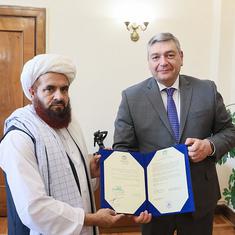My best friend and I have a tradition that is perhaps shared by thousands of Punjabis all over the world. I hurl a curse at him and he responds in similar fashion. Usually, I call him “Kanjar” and he calls me “Harami”. However, every time this word comes out of my mouth, there is a sense of shame accompanying it.
Not because I am embarrassed by my language, but by how easily I reinforce the structural biases inherent in language that give a particular word a particular connotation, making it a curse or a blessing. For example, there is nothing intrinsic about the word Kanjar that renders it a suitable curse for my dear friend. It becomes a curse because it is a product of societal prejudice that identifies one caste as a curse.
Kanjar, traditionally, were a nomadic tribe that eventually settled in different cities of India and Pakistan. In Pakistan, their caste is associated with the prostitution business, with the women serving as prostitutes and the men as pimps.
Fouzia Saeed from Islamabad, many years ago, wrote a wonderful anthropological account of the prostitutes of Lahore’s Hira Mandi in which she brought to life the sub-culture of the community. She talked about how within the community, the Kanjar caste holds a particular status because of their long association with the profession while prostitutes that do not belong to the Kanjar community are looked down upon. It is, therefore, interesting that while in broader society their caste becomes a curse, within their sub-culture it is a matter of honour.
Mirasi is another caste from Punjab that is looked down upon in society and referred to as a curse more often than not. A few years ago, I was interviewing a popular kirtan singer from Lahore whose ancestors belonged to the Mirasi clan but who was particular about not being associated with it because of the social stigma. Known as keepers of tradition, Mirasi in traditional Punjabi societies memorised and then narrated the heroic deeds of prominent families from their localities.
They were also associated with music. In Hira Mandi, they formed an integral part of the community, rendering their musical skills to the Kanjar. Young and old patrons from families of high caste and class descended upon this unholy mohalla every night to appreciate the music and dancing skills of the Mirasi and Kanjar – the same people who, once outside, cursed these professions and, hence, these castes, declaring them unacceptable in “civilised” society.
Nomadic clans
In urban and rural Punjab, where there is a systematic bias towards nomadic communities, Changar is another clan that is looked down upon in “respectable” society with all kinds of biases prevalent about their eating and mating habits. They are on the lower rungs of the caste hierarchy, a fact reflected in the connotation the word carries.
Chuhra and Mussali are other examples of “low” castes and usually used as slurs. Historically, members of the Chuhra community were associated with the sweeping profession and, hence, regarded as untouchables. Even after their conversion to Islam and Christianity, many community members continued to suffer the same treatment at the hands of their co-religionists.
In Pakistan, a particular situation has emerged regarding this caste and how it is conceived by a large segment of society in Punjab. Following the riots of Partition, a sizeable population of untouchable Hindus in the state converted to Christianity, but continued the same occupation. Therefore, one today finds a large population of Christians engaged in this profession. Over the years, as societal bias against the Christianity minority in a Muslim-majority country escalated, Chuhra was used as a derogatory term to refer to Christians from various castes.
Mussali is another “untouchable” community that converted to Islam but could not shrug off the stigma their clan carried. This word, like Chuhra, is used as a slur today.
Growing bias
While a lot of these biases are deep-rooted and go back several generations, there are other identities that have become curses as society around us changes. Today, Hindu is one such word that does not always have a positive connotation. It is sometimes used to refer to someone who cannot be trusted and is conniving. This social attitude reflects how our multi-religious society became monolithic after Partition.
Similarly, Yahudi, the Arabic translation for Jew, is another term now used as a slur. Perhaps there has always been a historical bias against Jews in the Muslim community, but the situation worsened after the creation of Israel and the word acquired a new connotation.
There are several other biases and racist slurs that are couched comfortably in our language and used unconsciously by its practitioners. Many people might not even have racist or casteist intentions as they use these words, but that does not condone them of the prejudice they create each time they refer to these communities as slurs. Kanjar, Mirasi, Chuhra and Changar are not insults but proud communities with a long history of perseverance in the face of major institutional bias. It is time our languages rid themselves of such biases premised upon centuries of discrimination.
Haroon Khalid is the author of the books In Search of Shiva: a study of folk religious practices in Pakistan and A White Trail: a journey into the heart of Pakistan’s religious minorities.










